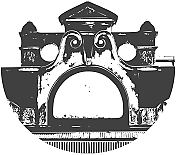GET OFF MY CLOUD
Helen Rogers
Angelica Roache-Wilson
ESSAY
GET OFF MY CLOUD features two artists whose very different approaches form and formlessness have an enchanting conversation through their art works. Form and formlessness seems a more suitable term than abstraction and figuration and so forth, because the presence of the material is elevated over the importance of the image. Helen Rogers’ works are visceral, squishy, a bit gross, and I want to touch them. Angelica Roache-Wilson’s works are compellingly calm and a little bit spooky.
Both artists eschew too much conceptual planning for a hands-on, process-driven approach. Rogers’ sculptural forms are consciously left at a certain point, in an attempt to retain the organic, primordial physical qualities of clay. Glazed and fired, these forms become frozen in their movement, and seemingly ache to be freed again in order to ooze and grow and move from plinth to plinth. Rogers’ glazes even suggest something otherworldly, echoing cosmic forms that change radically, but stretched over the eons become unknowable to us, or the tiniest globular life form that lives under a quiet rock. I imagine these creatures to freely move about the gallery in the cover of darkness, exploring, and spawning.
Roache-Wilson’s materials are decidedly sensuous (it would seem hard to strip oil of this aspect, but many unwittingly do), but they invite us to a different experience. Each work seems to be its own place, its own world. Small, quiet, and made with a surprising level of sensitivity, considering the artist’s use of paint. She really paints, and without the aversion to colour mixing of this generation (what is that all about?). Roache-Wilson’s work works best when it is playfully traversing the grey area between figuration and abstraction, in a very similar (though perhaps less physical) way as Helen’s work. Hints of forms emerge, but the artist gives us few clues. Deadpan titles like ‘Brown Object’, ‘Blue Shape with Stripes’ and ‘Six White Dots’ give nothing away, almost to the point of humour. The rest, I think, is up to us.
Bringing these two artists together becomes a wonderful conversation between forms and formlessness. We recognize something in these works, even if it is not quite identifiable. Close your eyes, and you can see them on the back of your eyelids, slowly dancing and shimmering.
Jonathan McBurnie 2015
